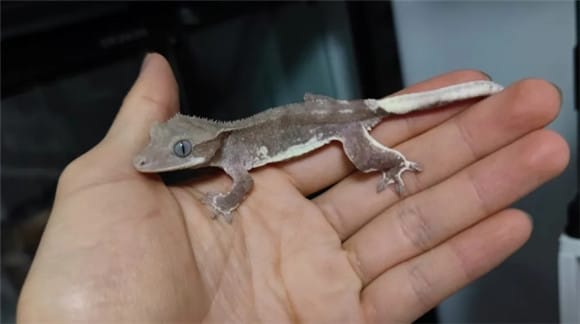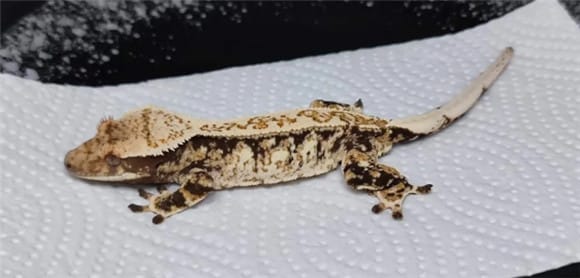Scientific name:
Ciliatus
Origin:
France-New Caledonia
Nouvelle-Calédonie
Ka: (pronunciation –kā)
The ciliary gecko
There are two spikes above the eyes The scales form the "eyelashes" and extend back to the neck, neck and back
This is the origin of the name "eyelash gecko"

"Artificially raised monster gecko - personally photographed by the big devil"
Historical origins of the gecko
Since it was first discovered in New Caledonia in 1866
No one has been found for a long time. Wild individuals
So the outside world generally believed that the ciliary gecko might become extinct due to human activities on the island
Until 1994, things took a turn for the better
New Khalifa Lidonia Islands – Live geckos rediscovered on Pine Island and some brought back to the United States legally
Smugglers are also illegally moving more geckos out of New Cali Donia
has become the ancestor of the geckos on the market
"New Caledonia Islands - Pine Island"
"Crysanthemum gecko in the wild"
After years of selective breeding
Nowadays, the eyelash-horned geckos come in various colors
"The above eyelash-horned geckos are all produced by the Great Demon King and photographed personally"
Climbing
Like other wall-climbing geckos
The ciliary geckos have special foot pads
which are covered with tens of thousands of tiny hairs made of keratin
The ends of the villi can generate friction on the surface of the object they are in contact with
Enlarged view of foot pads"
"The body and foot pads of the geckos are very soft"
"Worth a visit The mention is that the tail also has the ability to absorb."
Habitat environment
150-1000 meters above sea level
Cuddle up on leaves and sleep during the day
Become active at dusk (nocturnal)
Inhabit low trees and large shrubs
"New Caledonia Island Environment"
Even if the geckos are on the same island
the habitat range is different
"From top to bottom, they are giants, monsters, and horned ones. Habitat height"
"Monster gecko in the wild"
"Giant gecko in the wild"
< p>"Eggs are laid everywhere""Sarrazin gecko in the wild"
"Gegonia gecko in the wild"
< /p>
"Crocodile scale gecko in the wild"
"Crystal-horned gecko in the wild"
Food
Pure, crickets
ps: Need to supplement D3 calcium powder (crickets wrapped or pureed 7%)
Feeding frequency: 3-4 times a week
Adult: basically requires 15-18 months
Weight: 35-45 grams (adult)
As the age increases, there are also individuals reaching 80 grams
About raising
The gecko gecko is one of the easiest to raise

You only need to pay attention to the following feeding points
1. Place a water basin for drinking
You can also spray water on the tank wall at night, preferably at night
2. Mat material: kitchen paper towels are the best choice
3. Climbing objects
The devil gecko is an arboreal gecko. In the wild, it spends a long time in trees for activities and rest.
So climbing objects are also essential in the breeding environment
Use wooden sticks when raising in boxes
Use Portuguese cork (tree holes) when raising in glass tanks
4. Leaves
Regardless of whether they are real leaves or fake plants , can add another sense of security to your devil gecko
5. The adaptable temperature is 18-26 degrees, 23-24 is the best
Do not exceed 28 degrees
Humidity: 60%-70% is optimal
7. Food:
Fruit puree, crickets
(Need to add D3 calcium powder)
The Gecko is very similar to many other New Caledonian geckos. They are frugivores and insectivores
The breeding environment of the "Big Gecko":
< p>"The breeding environment of the big devil"
Lifespan
If raised properly, the lifespan can exceed 20 years
Eyes
No eyelids - unable to close eyes
Clean eyes by licking with tongue
Ears
The ciliary gecko has a The opposite ear holes are on both sides of the neck
The ear holes - inside are the eardrums that receive sound vibrations
The sense of smell
The upper palate has a highly developed The vomeronasal organ (VNO), Jacobson's organ, or Solanum testator's organ, is an auxiliary olfactory sensory organ used to sense the environment and functions similarly to smell or taste.
It is common to see geckos licking things around them, especially when they first arrive in a new environment. When their tongues come into contact with an object surface, a variety of odor molecules will attach to them. Then the tongues are retracted into the mouth, and the vomeronasal organ can analyze the molecules brought back. The vomeronasal organ can detect certain "odors", such as pheromones from nearby potential mating partners, marks left by hostile males, and may have a way to identify potential predators, food, etc.
Using your tongue to lick the walking surface is mostly for the chemical information left by other nearby geckos, and uses these hormones to find potential mating partners, follow commonly used paths and avoid the territory of hostile males
"Use your tongue to analyze the smell"
Tail
The tail of the gecko is different from other geckos:
< p>1. The tail also has a suction cup and has the ability to stick"You can hang the entire body with the tail"
2. The tail will not regenerate after being docked
There are almost no individuals with tails in the wild
Tail docking is normal in captivity
It does not affect health and reproduction
"Tail docking does not affect health and reproduction of individuals"
Reproduction
Sexual maturity basically takes 12-15 months
Weight at 12 months old Can reach 35-40 grams
(There are individual differences in weight)
Generally speaking
Male 35-40 grams participates in reproduction
Females weigh 40-45 grams and participate in reproduction
(The best age is over 14 months)
Mating usually occurs at night. During courtship, the male will bite the female's neck from behind, and then Straighten the body and use one of the two hemipenes to enter the female's cloaca to expel sperm
"The male will bite the female's neck and then straighten the body for mating"
"Male ciliary gecko"
Note: The two "balls" of the male are actually two "hemipenes"
Reproduction Box
Crysanthemum geckos can breed all year round
In order to ensure the fertilization rate
"The Big Devil" does this
Keep two males and two females or one male and three females in the same breeding box
In November, remove the male and let the female rest
"Shenzhen Reptile House "A corner of the breeding room"
Note:
Female ciliary geckos can still store sperm, so even if the male is removed
Some females will still be able to store sperm. Continue to produce fertilized eggs
Egg production
Female will look for a moist place to lay eggs that can keep eggs
So the breeding box needs to prepare a "delivery room" for the female< /p>
The purpose is to provide the female with a suitable birth environment
The "delivery room" - placing moist sphagnum moss in a container that can accommodate one or two adult females
< p>Basically, as long as a delivery room is provided, more than 99% of females will get under the sphagnum moss to lay eggsUsually, 3 to 5 weeks after mating
Females will lay eggs. A clutch of eggs
A clutch of eggs basically consists of two eggs. Occasionally, only one egg is laid
"As long as The females will basically lay eggs in the delivery room if they are placed in the delivery room."
After receiving the egg
You can see a red ring inside the egg through the light
See the sperm ring It proves that it is a fertilized egg
"The red circle is the sperm ring, which is a sign of fertilization"
The material of the hatching egg
Usually choose vermiculite or perlite
"Big Devil" uses diatomaceous earth
The hatching material needs to ensure its humidity, soak it in water and then drain the water
The above materials all have good water absorption
The water can still remain moist after draining
Incubation temperature
Recommended incubation of ciliary geckos The temperature is 22-25 degrees Celsius
The incubation temperature of "Big Devil" is controlled between 22-24 degrees Celsius
It is different from other geckos (such as fat-tailed geckos)
p>Based on current data and experience
The gender of the gecko is not determined based on the incubation temperature
but randomly
Placement of the egg
Gently use your fingers to remove the hatching material into a small pit
Bury half of the egg into the small pit
Semen ring upward
p>The embryo begins to develop just below the spermarium
"Egg placement"
Record
p>"Big Devil" will record the egg laying date of the female on the breeding box
and the hatching date on the egg box
to facilitate knowing the female's egg laying cycle The number of days of incubation of seedlings
Generally speaking, the female will lay a clutch of eggs in 3 to 5 weeks
The number of incubation days at 22-24 degrees is 75-100 days
"The Recording Method of the Big Devil"
Miaozi
After Miaozi emerges from the shell
Put it in an ordinary lunch box size Just raise them in boxes
At this time we need to use a watering can to wash away the egg liquid on the seedlings
and keep them moist
" When they first hatch, spray water to wash off the egg liquid on their bodies and maintain humidity."
Feeding of seedlings
When the geckos first hatch, they will have a layer of "fetal skin"
p>It will rub off the "fetal skin" on its own
One day after the fetal skin falls off
You can place a small amount of fruit puree for it to "start eating"
p>"Starting food" refers to the first time eating independently after birth
You can feed small crickets after 1-2 weeks
Usually 3-4 It can grow to 7-10 grams in one month
"Two larvae waiting for food"

 扫一扫微信交流
扫一扫微信交流
发布评论